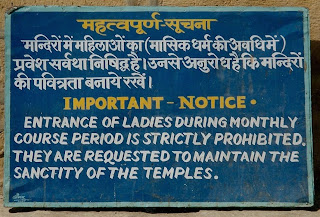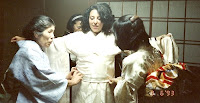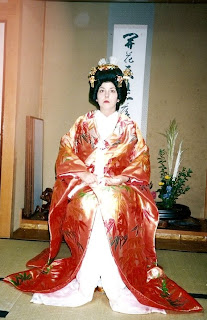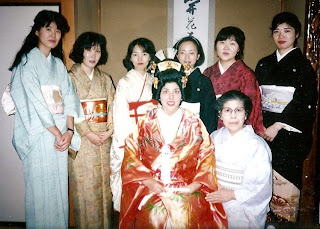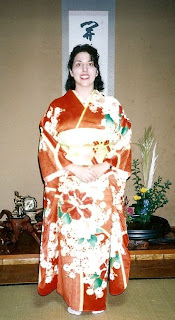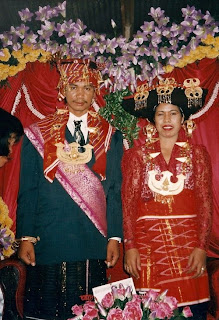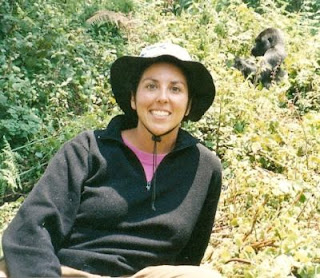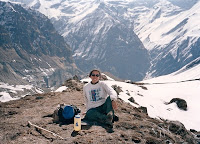 To carry my own bag or hire a porter? That was the question I had to answer. One seasoned trekker I met in Pokhara, Nepal said that if my backpack is less than 10 or 20 pounds (I no longer remember the exact weight), then I can do the trek on my own. If my backpack is 20 pounds (?) or more, then I should hire a porter. I felt that I was under this weight but I still had a winter coat to rent. I knew that if I were cold, I would not enjoy the experience in the mountains. Therefore, I decided to rent a very big, red down winter jacket with a fat hood that needed to be stuffed into my backpack. O.K. I was over the tipping point now. I decided to hire a porter. I had read several stories about problems with porters. Therefore, I decided to approach a reputable company. We agreed on payment terms. One of the last things I said as I walked out the door with my new porter was, "He has all the gear he needs, right?" The reply I received was "Yes, he does." Out the door we went.
To carry my own bag or hire a porter? That was the question I had to answer. One seasoned trekker I met in Pokhara, Nepal said that if my backpack is less than 10 or 20 pounds (I no longer remember the exact weight), then I can do the trek on my own. If my backpack is 20 pounds (?) or more, then I should hire a porter. I felt that I was under this weight but I still had a winter coat to rent. I knew that if I were cold, I would not enjoy the experience in the mountains. Therefore, I decided to rent a very big, red down winter jacket with a fat hood that needed to be stuffed into my backpack. O.K. I was over the tipping point now. I decided to hire a porter. I had read several stories about problems with porters. Therefore, I decided to approach a reputable company. We agreed on payment terms. One of the last things I said as I walked out the door with my new porter was, "He has all the gear he needs, right?" The reply I received was "Yes, he does." Out the door we went.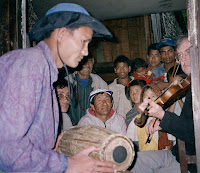 To make a long story short...3 days later I had to fire my porter named Ramkubar, who was drunk, wearing my hat, and playing the drum in the picture on the right. Ramkubar tried to sleep in my room the first 2 nights. He did not have the proper clothing for the cold. I was afraid he would lose his fingers or toes to frostbite or maybe go blind from the sun. I was not comfortable taking those chances and I was not about to buy him a full set of gear. He could have bought the necessary hand, foot, and eyewear in the next big village, but he was drinking away the money I was giving him each day. I could not have figured all of this out without the help of another trekker's guide, who provided translation between me and my porter. I am eternally grateful to this guide (picture - left side wearing glasses). He really went out on a limb for me by providing the honest translation that I needed to make the right decision. In a huge and embarrassing scene in front of a dozen porters and guides, I fired my porter. I gave my porter enough money for food, lodging, and transportation back to Pokhara. Although I had been wronged by my porter, I still made sure he was able to safely get out of the mountains. For this the other guides, porters, and people in the village respected me.
To make a long story short...3 days later I had to fire my porter named Ramkubar, who was drunk, wearing my hat, and playing the drum in the picture on the right. Ramkubar tried to sleep in my room the first 2 nights. He did not have the proper clothing for the cold. I was afraid he would lose his fingers or toes to frostbite or maybe go blind from the sun. I was not comfortable taking those chances and I was not about to buy him a full set of gear. He could have bought the necessary hand, foot, and eyewear in the next big village, but he was drinking away the money I was giving him each day. I could not have figured all of this out without the help of another trekker's guide, who provided translation between me and my porter. I am eternally grateful to this guide (picture - left side wearing glasses). He really went out on a limb for me by providing the honest translation that I needed to make the right decision. In a huge and embarrassing scene in front of a dozen porters and guides, I fired my porter. I gave my porter enough money for food, lodging, and transportation back to Pokhara. Although I had been wronged by my porter, I still made sure he was able to safely get out of the mountains. For this the other guides, porters, and people in the village respected me.
Although I was now 3 days into the mountain trek without a porter and I had a backpack that was too heavy for me to carry at high altitude, firing my porter was one of the best decisions I made. Based on a suggestion from another trekker, I approached the owner of the lodge I was staying in. I asked him if he could help find me a porter. The lodge owner of course knew everyone who lived in Ngadi, this small village in the mountains. He told me he would have someone for me the next morning.
 I will never forget meeting Kumbaru. This was the most awkward and uncomfortable meeting ever. Honestly, I am not proud of my first 15 minute interaction. First, I visually looked him over. Unlike my first porter, Kumbaru had very large, muscular thighs and appeared very sturdy. I felt like I was checking him out like a slave at auction during the days of slavery in the U.S. This was an awful feeling for me, but I could not make another mistake at an even higher altitude. After making a mental note of his physical attributes, I made him dump his bag and show me that he had the appropriate gear to get over the mountains. He had sun glasses, socks, and gloves for his hands. Lastly, I made sure that the lodge owner communicated to Kumbaru that he was never to touch me, sleep in my room, or drink alcohol. With that understandood and a final negotiation on financial terms, we were off. Based on those first 15 minutes I can only imagine Kumbaru was leery of spending a few weeks in the mountains with this insulting western woman.
I will never forget meeting Kumbaru. This was the most awkward and uncomfortable meeting ever. Honestly, I am not proud of my first 15 minute interaction. First, I visually looked him over. Unlike my first porter, Kumbaru had very large, muscular thighs and appeared very sturdy. I felt like I was checking him out like a slave at auction during the days of slavery in the U.S. This was an awful feeling for me, but I could not make another mistake at an even higher altitude. After making a mental note of his physical attributes, I made him dump his bag and show me that he had the appropriate gear to get over the mountains. He had sun glasses, socks, and gloves for his hands. Lastly, I made sure that the lodge owner communicated to Kumbaru that he was never to touch me, sleep in my room, or drink alcohol. With that understandood and a final negotiation on financial terms, we were off. Based on those first 15 minutes I can only imagine Kumbaru was leery of spending a few weeks in the mountains with this insulting western woman.

 The next night I reconnected with a couple of Americans I had passed on day 1. It turned out that they were from San Jose, CA, which was only an hour away from my home in San Francisco. Unbelievable! We, along with 1 more American, 2 Canadians, and 1 Australian, trekked the rest of the Annapurna circuit together. This worked out wonderfully because our porters trekked together as well. Now Kumbaru, who spoke no English, had others to hang out with during the daytime treks and the night time meals. Eventually I learned a little Nepalese and Kumbaru learned a little English. We all had a fantastic time together.
The next night I reconnected with a couple of Americans I had passed on day 1. It turned out that they were from San Jose, CA, which was only an hour away from my home in San Francisco. Unbelievable! We, along with 1 more American, 2 Canadians, and 1 Australian, trekked the rest of the Annapurna circuit together. This worked out wonderfully because our porters trekked together as well. Now Kumbaru, who spoke no English, had others to hang out with during the daytime treks and the night time meals. Eventually I learned a little Nepalese and Kumbaru learned a little English. We all had a fantastic time together.
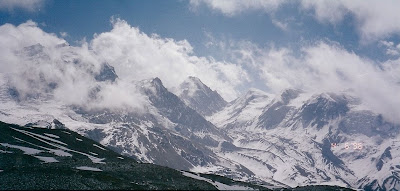 The Annapurna circuit took approximately 18 days. Including a couple of days for acclimatizing, we hit Thorung La Pass at 17,769 feet on day eleven. On day eleven we left at roughly 5:00 a.m. and we made it over the pass in groups. I hung back with Heather, the Australian who was ill with Guardia.
The Annapurna circuit took approximately 18 days. Including a couple of days for acclimatizing, we hit Thorung La Pass at 17,769 feet on day eleven. On day eleven we left at roughly 5:00 a.m. and we made it over the pass in groups. I hung back with Heather, the Australian who was ill with Guardia.  We were the last to reach Thorung La Pass at around 11 a.m. Descending was awful because we could not find the trail down. We had to slide on our butts over sharp, rocky snow. I even ripped my pants. At one point we were in a valley of snow and we heard a huge cracking noise. Heather and I did not say a word to one another but we started running like crazy. (Note: The pass closed 2 days later due to an avalanche.) Eventually a couple of our group's porters found the two of us and helped us get through the worst of it. At one point with the sun beaming down strong, my legs completely punched through the melting snow and I did a face plant. The two porters had to pull me out of my predicament. I had the hardest time on the descent because of the extreme pain in my knees. Heather and I met up with the others in Muktinath at around 3:30 p.m. Instead of a big group celebration that night, we mostly sat quietly, shaking our heads, and thanking G-d that we made it over. Honestly, we sat in disbelief. Before we made it over the pass, a few of us had thoughts of trekking to Everest Base Camp next. After making it over the pass, those thoughts were erased.
We were the last to reach Thorung La Pass at around 11 a.m. Descending was awful because we could not find the trail down. We had to slide on our butts over sharp, rocky snow. I even ripped my pants. At one point we were in a valley of snow and we heard a huge cracking noise. Heather and I did not say a word to one another but we started running like crazy. (Note: The pass closed 2 days later due to an avalanche.) Eventually a couple of our group's porters found the two of us and helped us get through the worst of it. At one point with the sun beaming down strong, my legs completely punched through the melting snow and I did a face plant. The two porters had to pull me out of my predicament. I had the hardest time on the descent because of the extreme pain in my knees. Heather and I met up with the others in Muktinath at around 3:30 p.m. Instead of a big group celebration that night, we mostly sat quietly, shaking our heads, and thanking G-d that we made it over. Honestly, we sat in disbelief. Before we made it over the pass, a few of us had thoughts of trekking to Everest Base Camp next. After making it over the pass, those thoughts were erased.
 On day 18 our big group split. Since I was enjoying being in the beautiful mountains and Kumbaru was such an amazing porter and now friend, Kumbaru and I continued on to do ABC (Annapurna Base Camp or the inner circuit) while the rest returned to Pokhara. We all said our goodbyes. Kumbaru said goodbye to his new buddies as well.
On day 18 our big group split. Since I was enjoying being in the beautiful mountains and Kumbaru was such an amazing porter and now friend, Kumbaru and I continued on to do ABC (Annapurna Base Camp or the inner circuit) while the rest returned to Pokhara. We all said our goodbyes. Kumbaru said goodbye to his new buddies as well. Now that it was just Kumbaru and I, Kumbaru never took his eyes off of me. My knees were very painful from the thousands of feet of descent. I walked with 2 sticks. Kumbaru walked immediately behind me to make sure I was alright at all times. At one point I had to say to him in Nepalese "I have to use the bathroom. Please walk ahead." I was then able to do a quick squat. I was so fortunate to have had Kumbaru as my porter. It turns out that Kumbaru had never been a porter for a trekker. He normally ported food and other very heavy supplies into the mountains. My backpack, which came with hip support, was considerably lighter than what he normally ported. Our 6 hours of trekking each day was also considerably lighter than what he was used to as well.
Now that it was just Kumbaru and I, Kumbaru never took his eyes off of me. My knees were very painful from the thousands of feet of descent. I walked with 2 sticks. Kumbaru walked immediately behind me to make sure I was alright at all times. At one point I had to say to him in Nepalese "I have to use the bathroom. Please walk ahead." I was then able to do a quick squat. I was so fortunate to have had Kumbaru as my porter. It turns out that Kumbaru had never been a porter for a trekker. He normally ported food and other very heavy supplies into the mountains. My backpack, which came with hip support, was considerably lighter than what he normally ported. Our 6 hours of trekking each day was also considerably lighter than what he was used to as well.
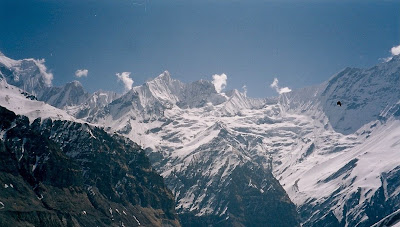 Since the inner circuit was at a lower altitude, Kumbaru and I were able to run and goof around on the trail. During our time together I had fun introducing Kumbaru to a Snickers candy bar and also binoculars.
Since the inner circuit was at a lower altitude, Kumbaru and I were able to run and goof around on the trail. During our time together I had fun introducing Kumbaru to a Snickers candy bar and also binoculars.  He was part of my introduction to dal bhat, which is made up of lentils, Yak cheese, which I absolutely love, and Yak scarf, which kept me warm. When I asked him if he had ever heard of McDonalds, he said no. When I asked him what his life dream was, he said to own land that he could farm. In the back of my mind I have always planned to return to Nepal and buy him that land. He was such a big part of making my experience in Nepal unforgettable. From time to time I wonder how he is doing and I truly hope he is in good health.
He was part of my introduction to dal bhat, which is made up of lentils, Yak cheese, which I absolutely love, and Yak scarf, which kept me warm. When I asked him if he had ever heard of McDonalds, he said no. When I asked him what his life dream was, he said to own land that he could farm. In the back of my mind I have always planned to return to Nepal and buy him that land. He was such a big part of making my experience in Nepal unforgettable. From time to time I wonder how he is doing and I truly hope he is in good health.
